A Fuzzy Based Handover Decision Scheme for Mobile Devices Using Predictive Model
Abstract
:1. Introduction
- Continuity of call
- Optimum radio link selection
- Traffic distribution
2. Related Work
3. Problem Statement
4. Proposed Methodology
4.1. Overview
4.2. Generation of Input Data for Mobility Prediction
4.3. Collection of Input Data
4.4. MFNN Model
4.5. Prediction Based Model
4.6. Optimal Network Selection Algorithm
- Initiation of new service request.
- The MT discover the availability of new network
- A user alters his preferences
- Critical signal degradation or complete signal loss of current radio link
- Strong signal quality implies the accessibility of a network. Accessible network is identified if its signal quality is strong.
- If a network with high optimal data rate is selected, it will reduce time of service delivery of non-real time system and improves the QoS of real-time system.
- A network with high reliability does not have an error and offers a high level of performance.
- Handover should be performed to a network where the battery power requirement is low.
4.7. Fuzzy Logic Technique
- The burst inputs are taken from chosen attributes and degree to which inputs of info have a place with each appropriate fuzzy set is resolved. This process is called fuzzification.
- At that point, this fuzzified input is taken and applied to the predecessor of the fuzzy principle and applied to ensuing part work.
- Aggregation is the step in which all the inputs are considered and merged.
- The output of the joined fuzzy set might be taken as input for defuzzification, and a single burst number is acquired as yield.
4.8. Fuzzification
- Signal Strength: (Good, Medium, Bad)
- Reliability: (High, Medium, Low)
- Battery Power: (Good, Medium, Bad)
- Mobile Terminal Velocity: (Good, Medium, Bad)
- Data rate: (Very fast, fast, slow)
- Signal strength (T)
- Reliability (R)
- Battery Power (B)
- Mobile terminal velocity (U)
- Data Rate (V)
4.9. Defuzzification
4.10. The Overall Algorithm
- Function Mobility_Prediction ()
- Initially, collection of Input data is done
- Apply sequence mining technique
- Collect training data set
- Determine the next cell
- If predicted cell is unable to satisfy requirement
- Then
- Apply function Multiple-attribute Access Network Selection ()
- consider values of parameters attribute, signal strength, reliability, battery power, mobility terminal velocity and data rate
- Apply function fuzzy logic decision () to decide the network
- Return the best network
5. Performance Evaluation
5.1. Experiment Setup
5.2. Metrics for Performance Analysis
6. Experimental Results
6.1. Scenario 1 (WiMAX to UMTS)
6.2. Scenario 2 (UMTS to WiMAX)
7. Conclusions
Author Contributions
Funding
Conflicts of Interest
References
- Arunkumar, S.; Rajkumar, P. Fast Re-Authentication for Efficient and Coherent Handover in 4G Networks. Int. J. Adv. Res. Comput. Eng. Technol. IJARCET 2014, 3, 1353–1358. [Google Scholar]
- Lee, M.; Park, S. A Secure Context Management for QoS-Aware Vertical Handovers in 4G Networks. Commun. Multimed. Secur. 2005, 3677, 220–229. [Google Scholar]
- Dhar, T.; Koner, C. Password and Biometric Based Mutual Authentication Technique for 4-G Mobile Communications. IRACST Int. J. Comput. Sci. Inform. Technol. Secur. (IJCSITS) 2013, 3, 2. [Google Scholar]
- Bhattacharjee, P.K.; Kumar Pal, R. Mutual Authentication Technique Applying Three Entities in 4-G Mobile Communications. Int. J. Comput. Theory Eng. 2011, 3, 6. [Google Scholar]
- Li, S.; Xu, L.D.; Zhao, S. 5G Internet of Things: A survey. J. Ind. Inf. Integr. 2018, 10, 1–9. [Google Scholar] [CrossRef]
- Schröder, F. Future Telco. New York; Springer: Berlin/Heidelberg, Germany, 2019; pp. 63–74. [Google Scholar] [CrossRef]
- Patil, H.J.; Patil, D.T. Internet of Things & its application to the libraries. In Proceedings of the Internet of Things and Current Trends Libraries (ITCTL), Mehsana, India, 18–20 January 2018; pp. 1–12. [Google Scholar]
- Stamou, A.; Dimitriou, K.; Kontovasilis, K.; Papavassiliou, S. Autonomic handover management for heterogeneous networks in a future Internet context: A survey. IEEE Commun. Surveys Tuts. 2019, 21, 3274–3297. [Google Scholar] [CrossRef]
- Reddy, S.; Venkatarama, S. A comprehensive survey on seamless mobility management in 5G communications. Int. J. Future Gener. Commun. Netw. 2018, 11, 33–48. [Google Scholar]
- Alsaeedy, R.; Chong, E.K.P. A review of mobility management entity in LTE networks: Power consumption and signaling overhead. Int. J. Netw. Manag. 2020, 30. [Google Scholar] [CrossRef]
- Abhinav, K.; Purohit, H. A Comparative Study of Different Types of Handover Strategies in Cellular Systems. Int. J. Adv. Res. Comput. Commun. Eng. 2013, 2, 4278–4287. [Google Scholar]
- Gondara, M.K.; Kadam, S. Requirements of Vertical Handover Mechanism in 4G Wireless Networks. Int. J. Wirel. Mobile Netw. IJWMN 2011, 3, 18–27. [Google Scholar]
- Meetei, K.P.; George, A. Handover Management in Wireless Networks Using Predictive Modelling. In Proceedings of the National Conference on Communications, Bangalore, India, 28–30 January 2011; pp. 1–5. [Google Scholar]
- Liu, C.; Zhou, C. Challenges and Solutions for Handover Issues in 4G Wireless Systems-An Overview. In Proceedings of the International Latin American and Caribbean for Engineering and Technology, Miami, FL, USA, 2–4 June 2004; pp. 1–6. [Google Scholar]
- Lauridsen, M.; Gimenez, L.C.; Rodriguez, I.; Sorensen, T.B.; Mogensen, P. From LTE to 5G for connected mobility. IEEE Commun. Mag. 2017, 55, 156–162. [Google Scholar] [CrossRef]
- Yuan, G.; Zhang, X.; Wang, W.; Yang, Y. Carrier aggregation for LTE-advanced mobile communication systems. IEEE Commun. Mag. 2010, 48, 88–93. [Google Scholar] [CrossRef]
- Nkansah-Gyekye, Y.; Agbinya, J. An Optimum Vertical Handover Decision Algorithm for UMTS-WiMAX. In Proceedings of the 2nd IFIP International. Symposium on Wireless Communications and Information Technology in Developing Countries, Pretoria, South Africa, 6–7 October 2008; pp. 1–6. [Google Scholar]
- Janevski, T.; Jakimoski, K. Improving Vertical Handovers for Real-Time Video Traffic between UMTS and WiMAX Networks. Int. J. Res. Rev. Next Gener. Netw. 2011, 1. Available online: https://www.researchgate.net/publication/228894985_Improving_Vertical_Handovers_for_Real-Time_Video_Traffic_between_UMTS_and_WiMAX_Networks (accessed on 1 October 2020).
- Pattnaik, L.; Mohanty, M.N.; Mohanty, B. An Intelligent Method for Handover Decision in Next Generation Wireless Network; Lecture Notes in Computer Science; Springer: Berlin/Heidelberg, Germany, 2013; Volume 8298, pp. 465–475. [Google Scholar]
- Khan, M.; Ahmad, A.; Khalid, S.; Ahmed, S.H.; Jabbar, S.; Ahmad, J. Fuzzy Based Multi-Criteria Vertical Handover Decision Modeling in Heterogeneous Wireless Networks. Multimed. Tools Appl. 2017, 76, 24649–24674. [Google Scholar] [CrossRef]
- Malathy, E.M.; Muthuswamy, V. State of art: Vertical handover decision schemes in next-generation wireless network. J. Commun. Inform. Netw. 2018, 3, 43–52. [Google Scholar] [CrossRef]
- Ahmadi, K.; Miralavy, S.P.; Ghassemian, M. Software-defined networking to improve handover in mobile edge networks. Int. J. Commun. Syst. 2020, 33, 25–33. [Google Scholar] [CrossRef]
- Driouache, S.; Naja, N.; Jamali, A. Fuzzy Logic Based Intelligent Vertical Handover Decision in Heterogeneous Networks. In Artificial Intelligence and Industrial Applications; Masrour, T., El Hassani, I., Cherrafi, A., Eds.; Springer: Berlin/Heidelberg, Germany; Cham, Switzerland, 2020; p. 144. [Google Scholar] [CrossRef]
- Palas, M.R.; Islam, M.R.; Roy, P.; Razzaque, M.A.; Alsanad, A.; AlQahtani, S.A.; Hassan, M.M. Multi-criteria handover mobility management in 5G cellular network. Comput. Commun. 2021, 174, 81–91. [Google Scholar] [CrossRef]
- Storck, C.R.; Efrem, E.D.O.; Guilherme, G.D.O.; Mini, R.A.; Duarte-Figueiredo, F. FiVH: A Solution of Inter-V-Cell Handover Decision for Connected Vehicles in Ultra-Dense 5G Networks. Veh. Commun. 2021, 28, 100307. [Google Scholar]
- Liu, Q.; Kwong, C.F.; Wei, S.; Li, L.; Zhang, S. Intelligent Handover Triggering Mechanism in 5G Ultra-Dense Networks via Clustering-Based Reinforcement Learning. Mobile Netw. Appl. 2021, 26, 27–39. [Google Scholar] [CrossRef]
- Shayea, I.; Ergen, M.; Azmi, M.H.; Çolak, S.A.; Nordin, R.; Daradkeh, Y.I. Key Challenges, Drivers and Solutions for Mobility Management in 5G Networks: A Survey. IEEE Access 2020, 8, 172534–172552. [Google Scholar] [CrossRef]
- Minimum Requirements Related to Technical Performance for IMT-2020 Radio Interface(s), Document ITU-R M.2410-0. 2017. Available online: https://www.itu.int/dms_pub/itu-r/opb/rep/R-REP-M.2410-2017-PDF-E.pdf (accessed on 3 September 2020).
- Pi, Z.; Khan, F. An introduction to millimeter-wave mobile broadband systems. IEEE Commun. Mag. 2011, 49, 101–107. [Google Scholar] [CrossRef]
- Lee, S.K.; Sriram, K.; Kim, K.; Kim, Y.H.; Golmie, N. Vertical Handover Decision Algorithms for Providing Optimized Performance in Heterogeneous Wireless Networks. IEEE Trans. Veh. Technol. 2009, 58, 865–881. [Google Scholar]
- Abdoulaziz, I.H.; Renfa, L.; Fanzi, Z. Handover Necessity Estimation for 4G Heterogeneous Networks. Int. J. Inform. Sci. Tech. 2012, 2, 1–13. [Google Scholar] [CrossRef]
- Aitmansour, A.; Enneya, N.; Ouadou, M.; Aboutajdine, D. Handover between WiMAX and WiFi Networks. In Proceedings of the Second International Conference on Innovative Computing Technology, Casablanca, Morocco, 18–20 September 2012; pp. 69–74. [Google Scholar]
- Miyim, A.M.; Ismail, M.; Nordin, R.; Ismail, M.T. Technique for Cross-layer Vertical Handover Prediction in 4G Wireless Networks. Procedia Technol. 2013, 11, 114–121. [Google Scholar] [CrossRef]
- Network Simulator. Available online: http://www.isi.edu/nsnam/ns (accessed on 12 March 2021).

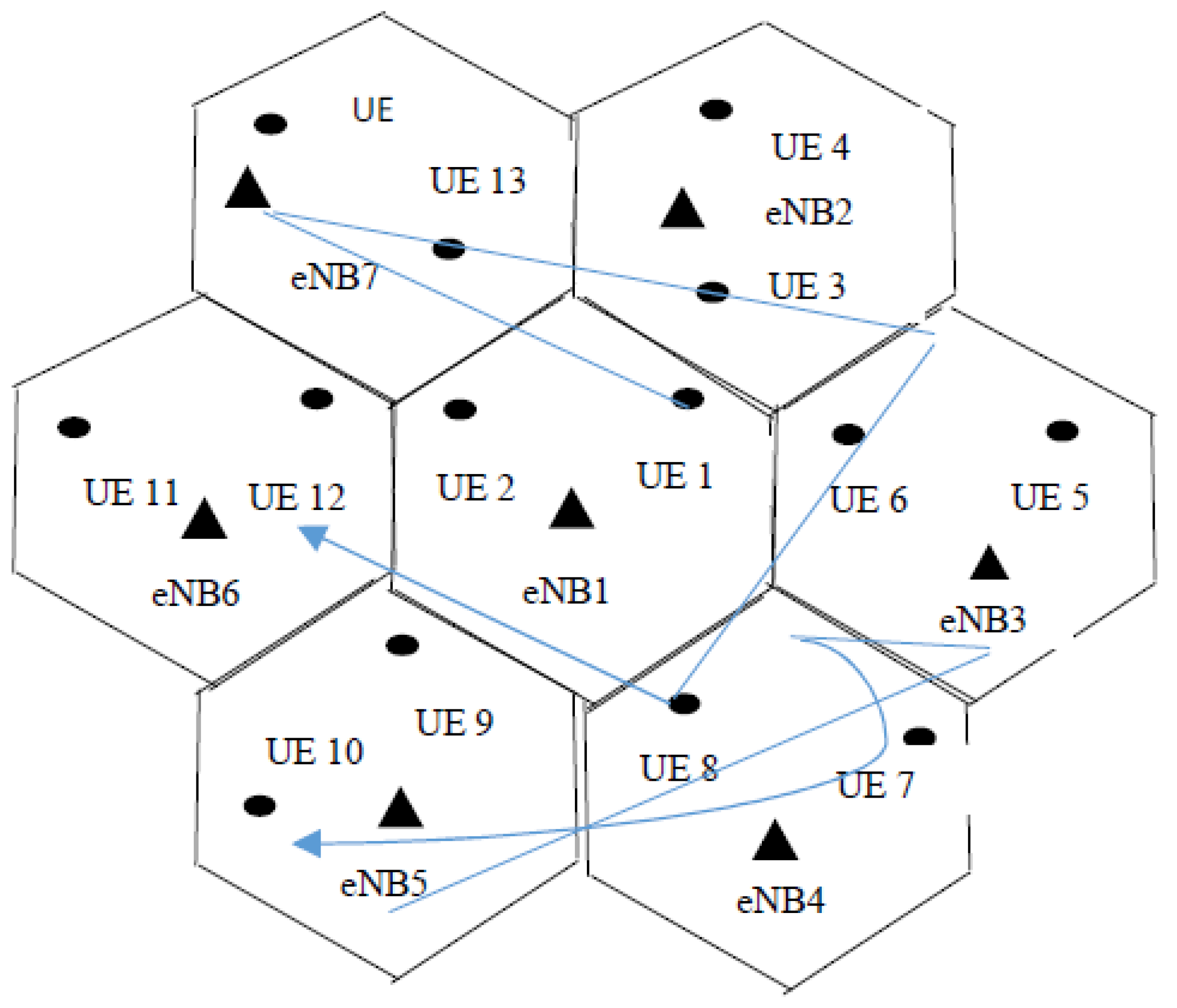

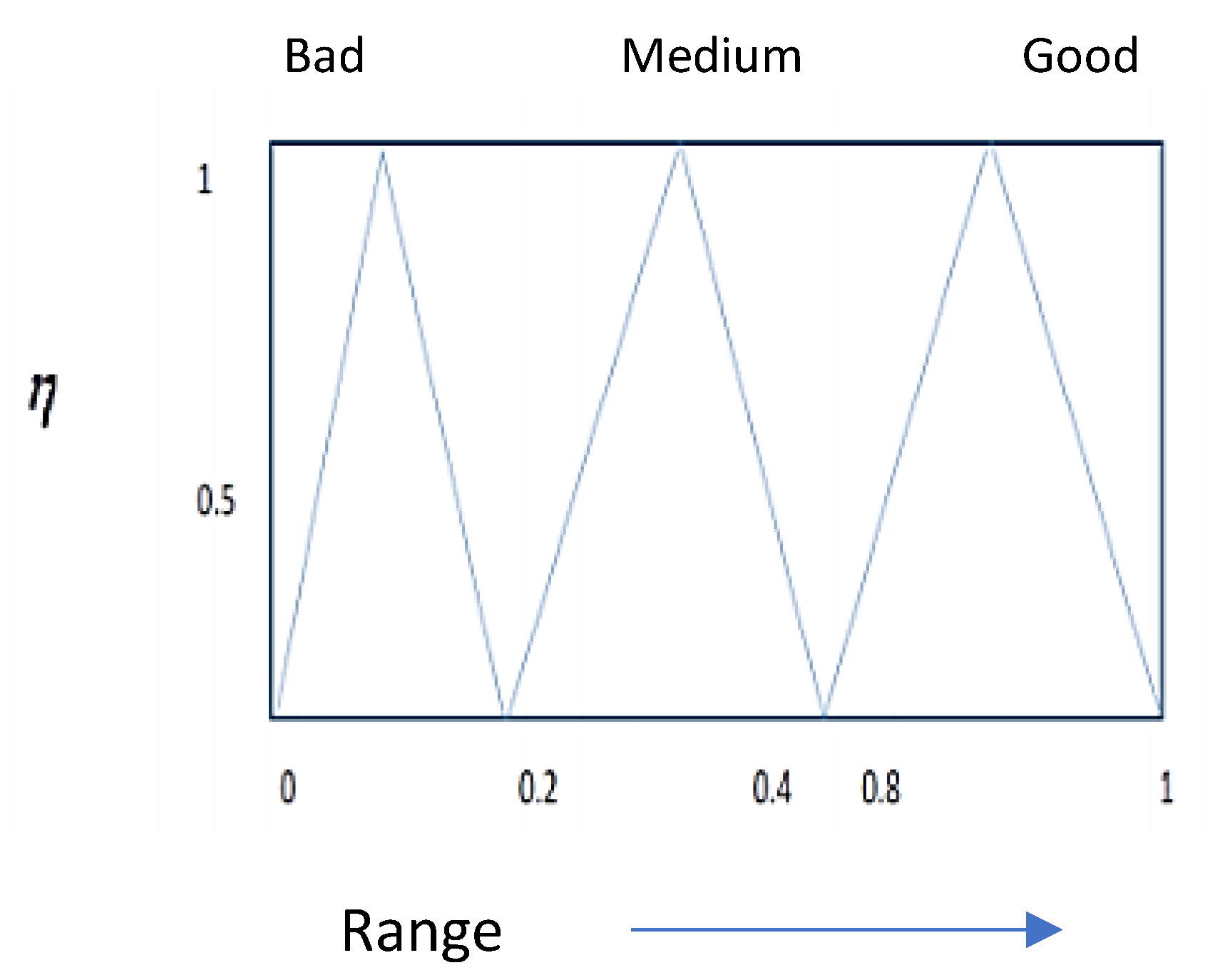

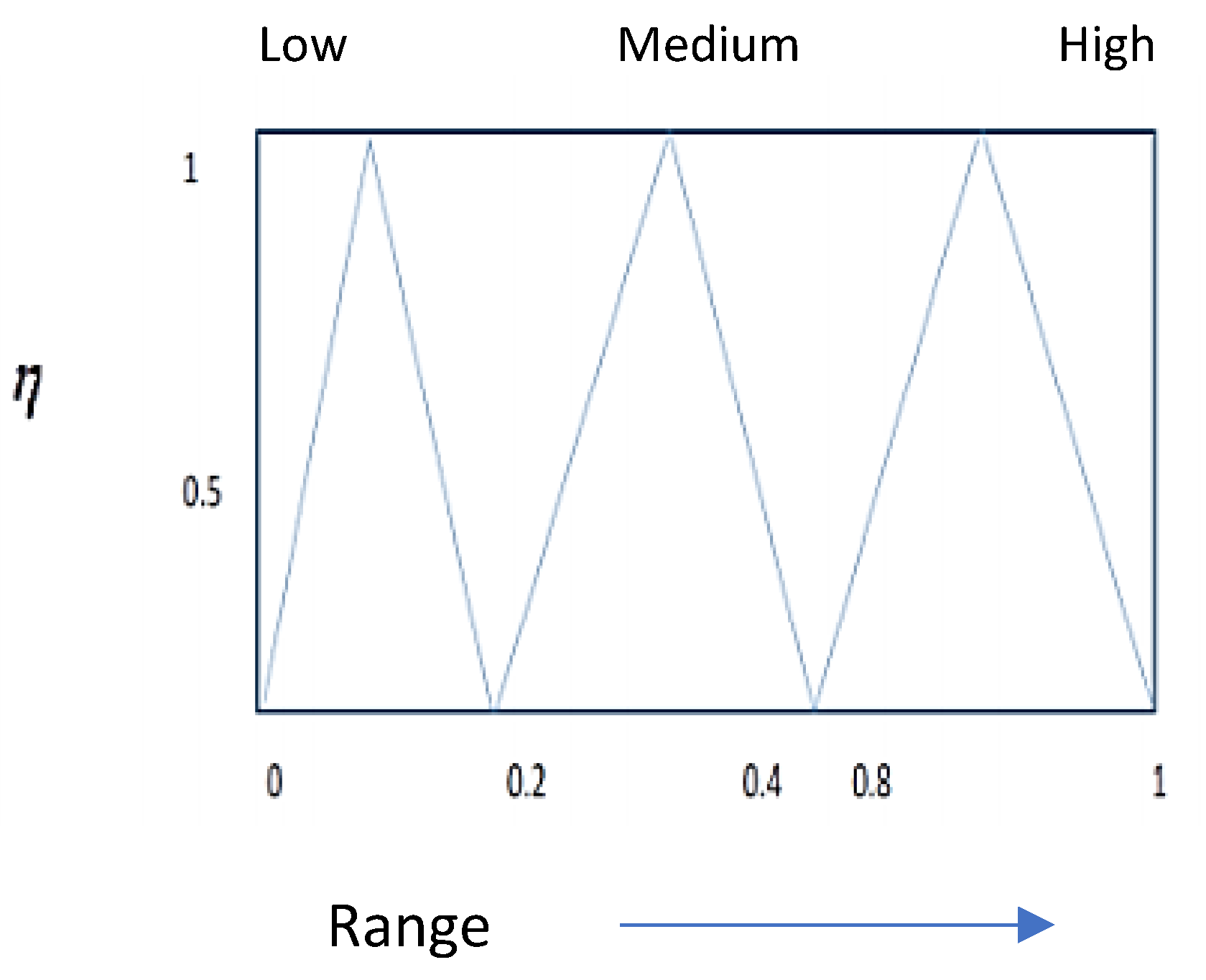
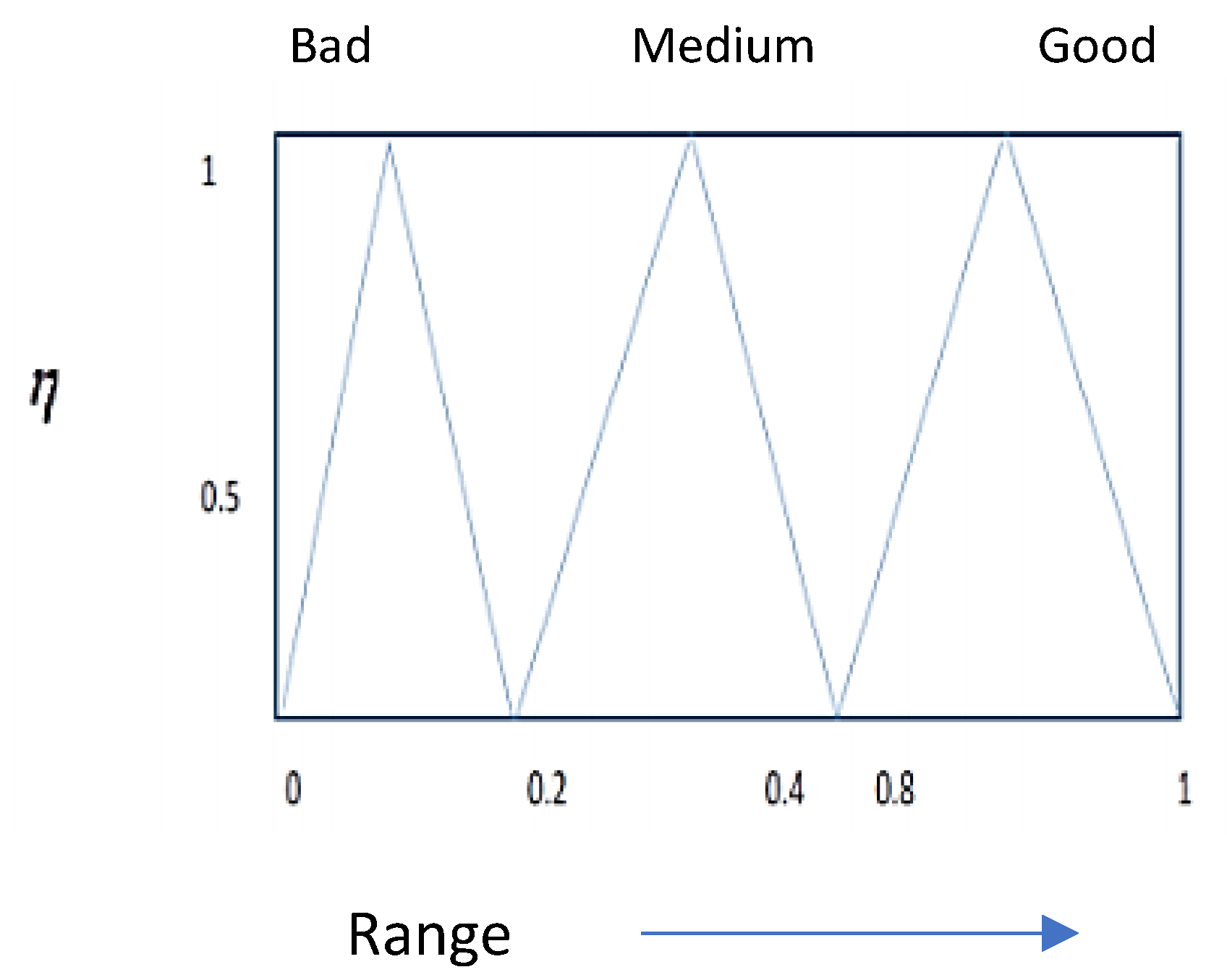
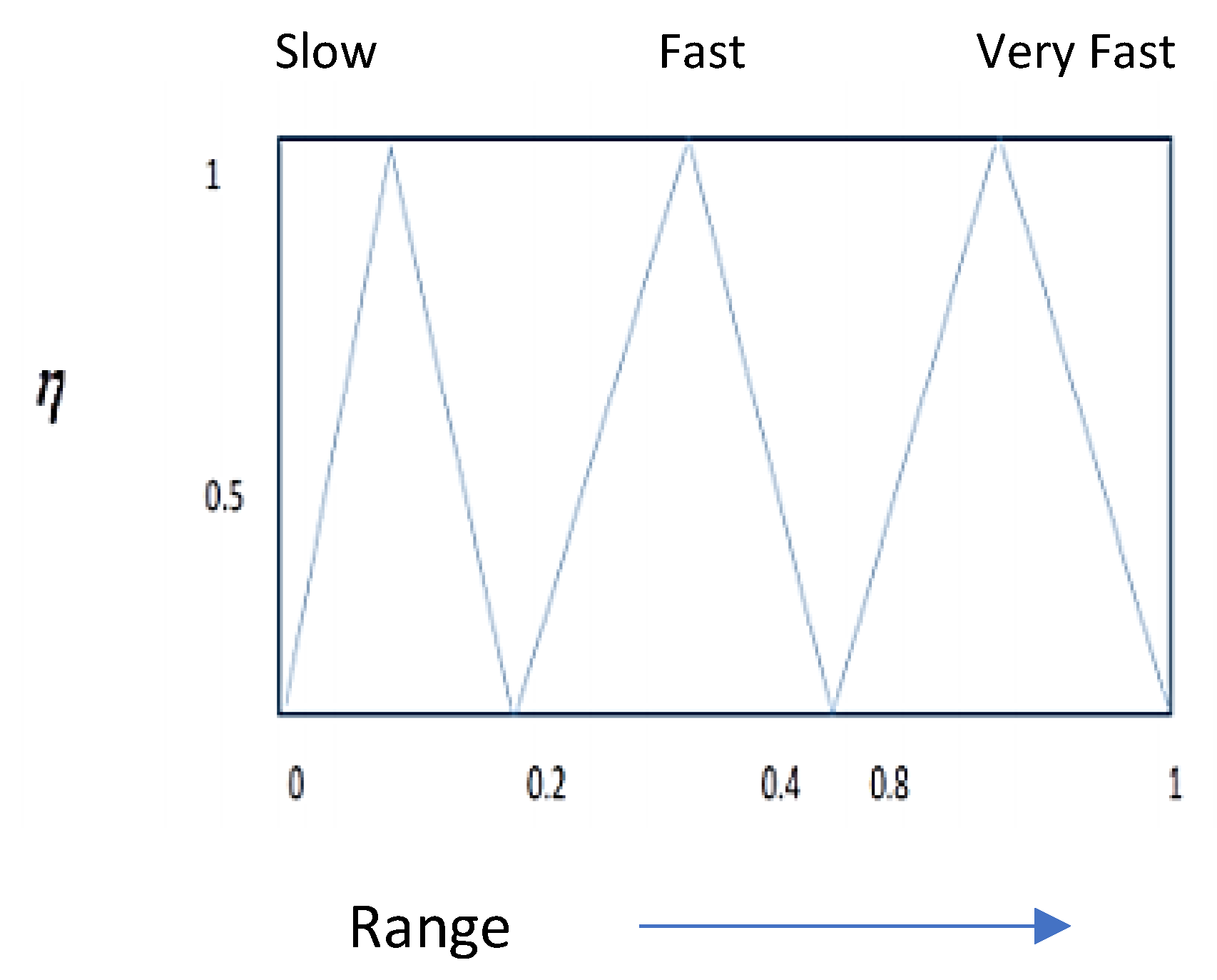
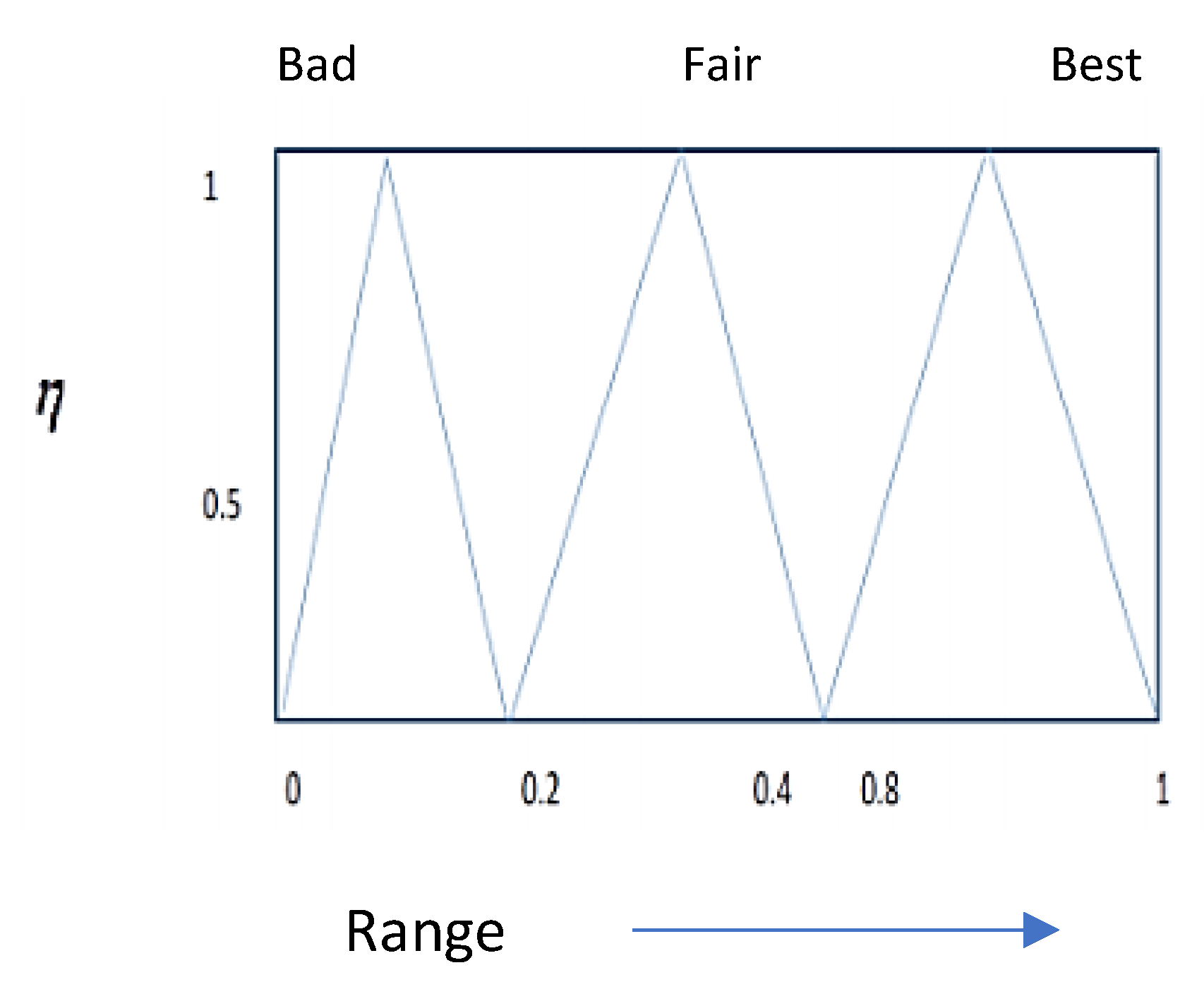



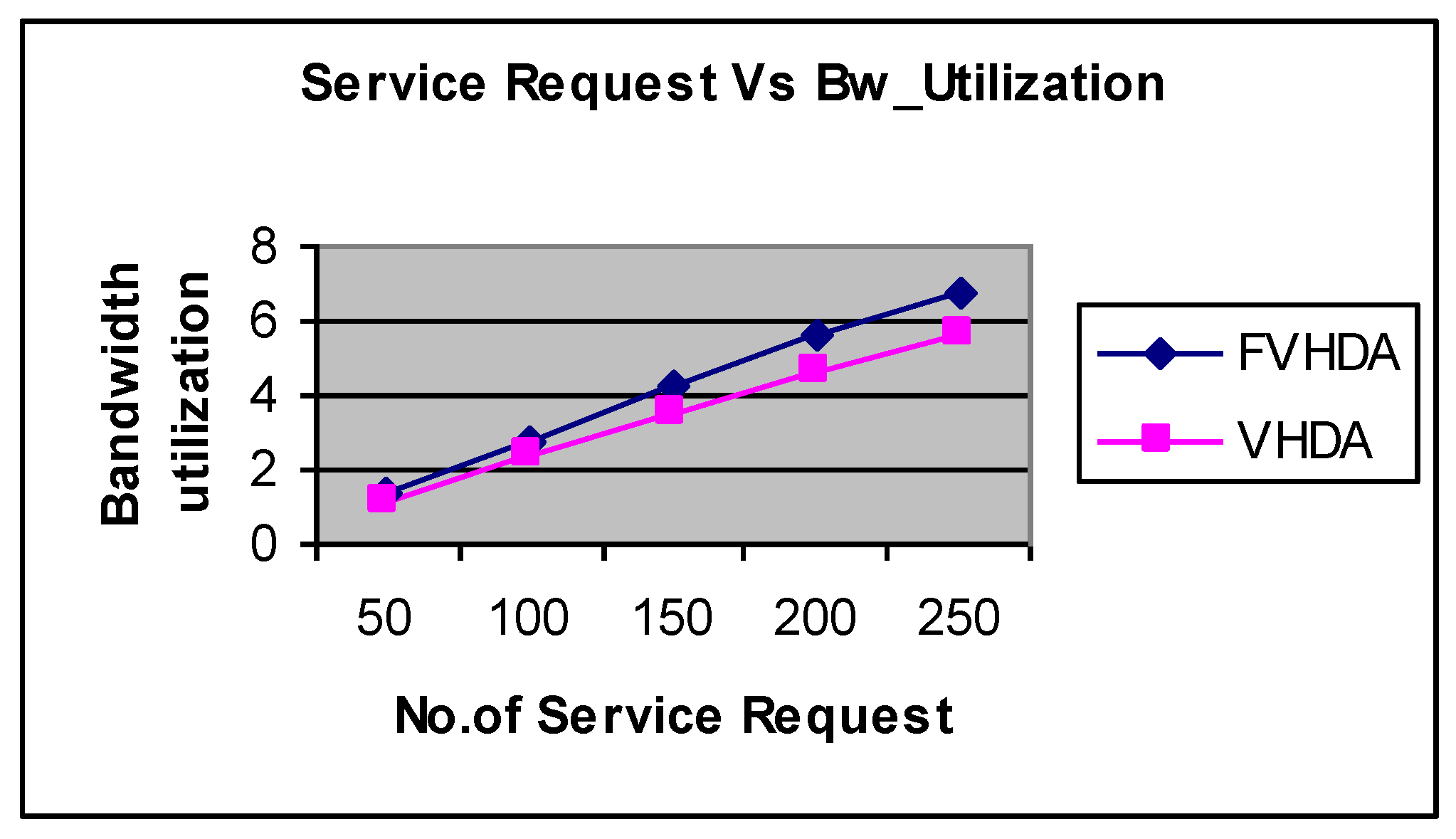

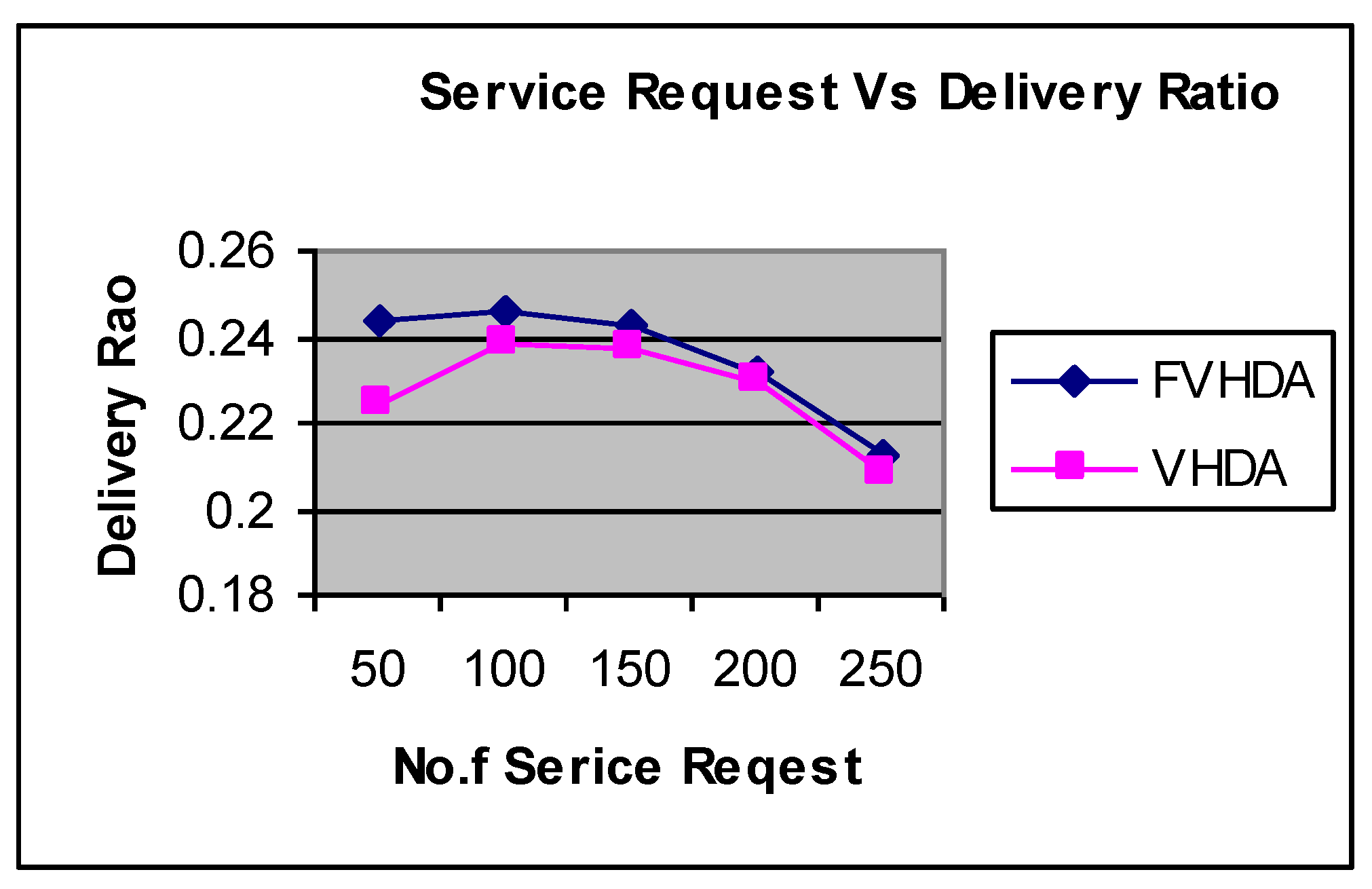
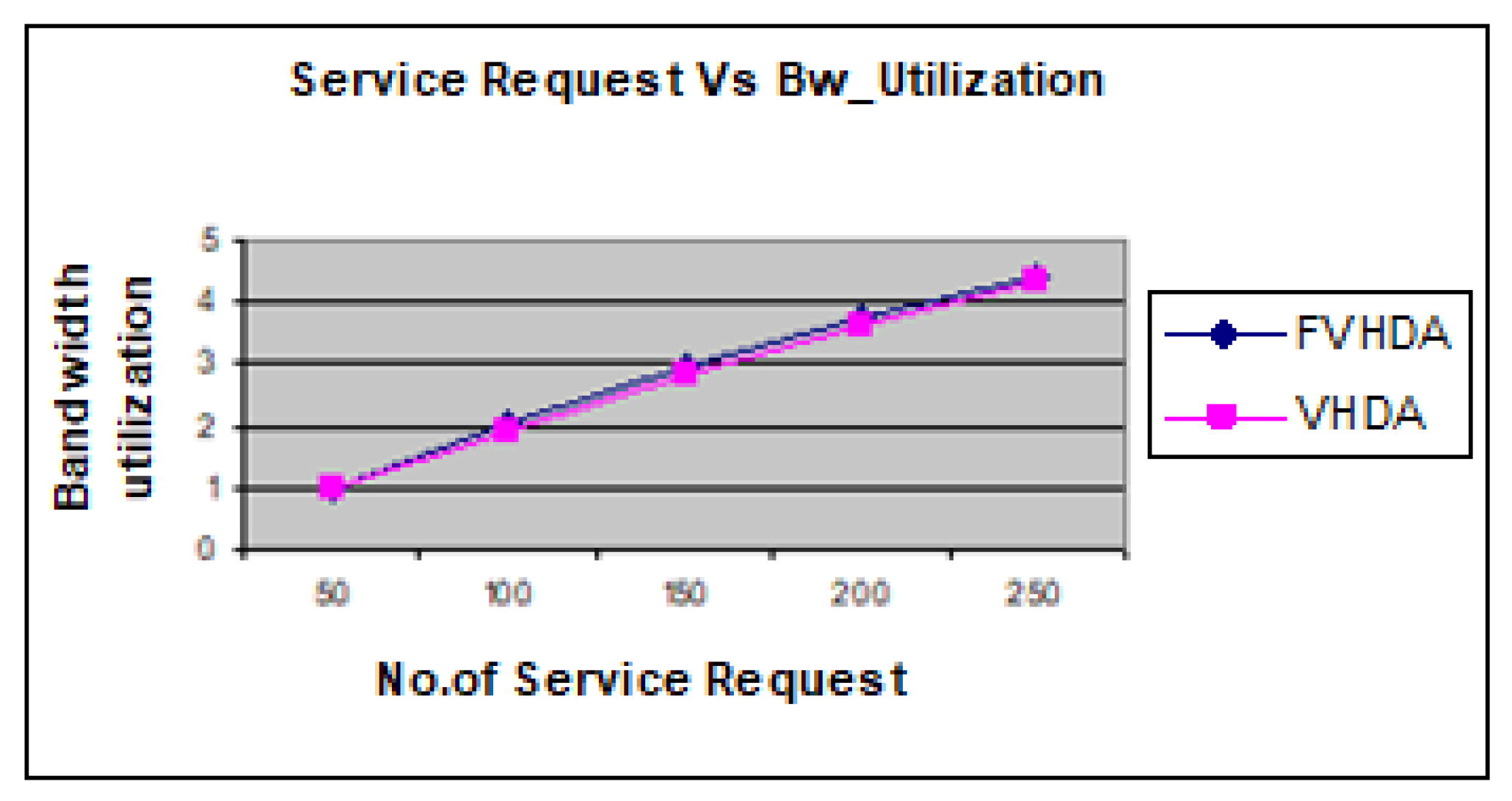
| UEID1 | Cell ID1 | Dwell Time1 | Cell ID2 | Dwell Time2 | Cell ID3 | Dwell Time3 |
| Sub-Pattern | Input Training Data 1 | Input Training Data 2 | Input Training Data 3 | Input Training Data 4 | Desired Output |
|---|---|---|---|---|---|
| 1 | |||||
| 2 | |||||
| 3 |
| Layer | Signal Strength | Reliability | Battery Power | Mobile Terminal Velocity | Data Rate |
|---|---|---|---|---|---|
| Routing layer | T | R | B | U | V |
| Rule | T | R | B | U | V | N (o/P) |
|---|---|---|---|---|---|---|
| 1 | Good | Medium | Low | Bad | Slow | Bad |
| 2 | Medium | Medium | Low | Bad | Slow | Bad |
| 3 | Bad | Low | High | Bad | Slow | Bad |
| 4 | Medium | Medium | High | Medium | Fast | Fair |
| 5 | Medium | Medium | Low | Medium | Fast | Fair |
| 6 | Good | Medium | Medium | Medium | Fast | Fair |
| 7 | Good | Medium | Medium | Medium | Slow | Fair |
| 8 | Medium | Medium | High | Good | Fast | Fair |
| 9 | Medium | High | High | Medium | Fast | Fair |
| 10 | Medium | High | Low | Medium | Very fast | Fair |
| 11 | Medium | Medium | High | Medium | Fast | Fair |
| 12 | Good | High | Low | Medium | Fast | Fair |
| 13 | Bad | High | Low | Bad | Slow | Bad |
| 14 | Bad | Low | Low | Bad | Slow | Bad |
| 15 | Bad | Low | Medium | Medium | Fast | Fair |
| 16 | Medium | Low | High | Good | Very fast | Fair |
| 17 | Medium | Medium | Medium | Medium | Fast | Fair |
| 18 | Good | Medium | Low | Bad | Bad | Bad |
| 19 | Good | Medium | Medium | Good | Fast | Fair |
| 20 | Good | High | High | Good | Very Fast | Best |
| Mobile Nodes No. | 30 |
|---|---|
| Network Size | 1000 × 1000 |
| Mac standard | IEEE 802.11 |
| Time | 35 sec |
| Simulation Traffic | CBR |
| Packet Size | 100 |
| Rate | 50 Kb/s, 100 Kb/s, 150 Kb/s, 200 Kb/s and 250 Kb/s. |
| Propagation Model | TwoRayGround |
| Antenna type | OmniAntenna |
Publisher’s Note: MDPI stays neutral with regard to jurisdictional claims in published maps and institutional affiliations. |
© 2021 by the authors. Licensee MDPI, Basel, Switzerland. This article is an open access article distributed under the terms and conditions of the Creative Commons Attribution (CC BY) license (https://creativecommons.org/licenses/by/4.0/).
Share and Cite
Gupta, A.K.; Goel, V.; Garg, R.R.; Thirupurasundari, D.R.; Verma, A.; Sain, M. A Fuzzy Based Handover Decision Scheme for Mobile Devices Using Predictive Model. Electronics 2021, 10, 2016. https://doi.org/10.3390/electronics10162016
Gupta AK, Goel V, Garg RR, Thirupurasundari DR, Verma A, Sain M. A Fuzzy Based Handover Decision Scheme for Mobile Devices Using Predictive Model. Electronics. 2021; 10(16):2016. https://doi.org/10.3390/electronics10162016
Chicago/Turabian StyleGupta, Amit Kumar, Vikas Goel, Ruchi Rani Garg, Dasarada Rajagopalan Thirupurasundari, Ankit Verma, and Mangal Sain. 2021. "A Fuzzy Based Handover Decision Scheme for Mobile Devices Using Predictive Model" Electronics 10, no. 16: 2016. https://doi.org/10.3390/electronics10162016
APA StyleGupta, A. K., Goel, V., Garg, R. R., Thirupurasundari, D. R., Verma, A., & Sain, M. (2021). A Fuzzy Based Handover Decision Scheme for Mobile Devices Using Predictive Model. Electronics, 10(16), 2016. https://doi.org/10.3390/electronics10162016







